A mother’s quest to end five decades of silence, pain
It was 1975. The Vietnam War had just ended. Microsoft was brand new. "The Hustle" reigned in discos, and a movie about a great white shark, Jaws, was terrorizing theaters.
That same year, 18-year-old Teresa “Bunny” Fittin backed out of her driveway in Fort Lauderdale, Florida in her 1966 Nash Rambler – and disappeared. Her mother has been searching for her ever since.
"She just vanished from the face of the earth," said Jocelia Travisano, now 87 and still living in South Florida. "I just want to know what happened to my child. Maybe she had an accident and went into a canal. Maybe Ted Bundy killed her. If she's still alive and she didn't contact us, that would be hard to believe."
Mother and daughter were very close. Her father wanted to name her Bunny if she was born on Easter Sunday. She arrived a bit early, on Good Friday, and the name stuck. Bunny’s mother and father met when they were teenagers, married young and were divorced soon after.

Bunny’s father came up with her name.
Fresh out of high school, Bunny was working as a waitress at a hotel on Fort Lauderdale Beach. She was petite. “A little bit of a thing, maybe five feet tall,” her mother said.
A talented seamstress, Bunny made the drapes for her first apartment in an older building with no air-conditioning but full of charm. “Like something out of a movie in Key West,” her mother recalled.
Over the last 50 years, many detectives have worked on her case, according to Travisano. Police brought in psychics. In 1975, missing children could not be entered into the FBI’s national crime database, although stolen cars could.
Six years after Bunny vanished, 6-year-old Adam Walsh was abducted from a shopping mall about 20 minutes away in Hollywood, Florida. Years later, his father, John Walsh, reached out to Travisano, inviting her to appear on TV for National Missing Children’s Day to talk about Bunny’s disappearance. She was still too heartbroken to speak publicly.

Photo taken of Bunny and her mom not long before she vanished.
John and his wife Reve΄ co-founded the National Center for Missing & Exploited Children (NCMEC) in 1984, nine years after Bunny vanished. In 2007, Fort Lauderdale police reached out to NCMEC for help as Bunny’s case grew cold.
We produced age progressions to show what she might look like as time passed, searched public records and databases for traces of her or her car, supported biometric analysis and, in 2016, dispatched a team of consultants to conduct a case review on-site.
Over the years, theories have swirled – maybe Bunny had a fight with her boyfriend, maybe she was pregnant. Police say she was reported missing on Aug. 1, 1975, but her neighbor remembers seeing her the next day, dressed nicely and pulling out of the driveway in her 1966 Nash Rambler. “If she were pregnant, she would’ve told me,” Travisano said.
Bunny’s disappearance took a toll. Two years later, tragedy struck again – Bunny’s younger brother, Daniel, a standout athlete being scouted by colleges, took his own life. Their mother eventually found some solace through counseling and helping others.

Bunny and her brother, Danny, in 1969.
Each time Travisano tried to revive interest in the case, the response felt the same: “Just another runaway.” It was a painful dismissal. Decades later, she still wonders — could Bunny have been one of Ted Bundy’s victims? He was active in Florida in the mid-1970s, targeting young women not unlike her daughter.
A non-profit group, Sunshine State Sonar, is helping search the more than 1,600 miles of canals across Florida, hoping to find Bunny’s car. They've recovered many — just not hers.
“It’s been 50 years,” said Travisano. “I’ve had so many people tell me different things. If they find her car, that will solve the mystery for me.”
If you have any information, please contact Fort Lauderdale Police at 954-764-HELP or NCMEC at 1-800-THE-LOST (1-800-843-5678).
